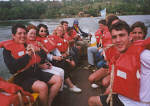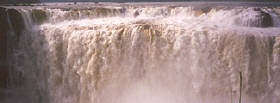Celebrating my birthday in a different country every year has become an inevitable tradition. This year, I chose to spend it in South America’s Iguaçú Falls. Without fail, Iguaçú Falls ranks up there as one of Mother Nature’s greatest creations. Nearly four times wider and slightly taller than Niagara, Iguaçú Falls is located at the confluence of three major South American countries – Brazil, Argentina and Paraguay.
|
The town of Foz do Iguaçú is the starting point for all Iguaçú Falls-based adventures. Considering all the tourist dollars that pass through here, it is nothing more than a seedy little local town with basic tourist amenities. Debating where to stay during my 4-day visit, I enlisted the help of the rodoviaria (bus terminal) tourism booth. It was there that I spoke with a tourist representative who suggested that I stay at the International Youth Hostel (IYH), centrally located in downtown. Come to think of it, it’s been ten years since my college days, therefore staying at a “youth” hostel never even crossed my mind. However, there is always a first time for everythingÂ…
The people that I met at Albergue da Juventude (International Youth Hostel) were of various age ranges and nationalities, and to my good fortune, primarily English-speaking. I was eternally grateful because my first three days in Brazil proved to be very difficult because of my lack of knowledge in Portuguese, Brazil’s official language.
I met Europeans, Germans and Spaniards in particular, and a few stray Americans, Canadians, Colombians, and Brazilians, and we managed to communicate for the most part. Everyone had his/her own opinions regarding which side is more beautiful – Brazil or Argentina – so I visited both sides to come to my own conclusion. I loved both because each side offered different perspectives of the park and no two viewpoints are alike.
Iguaçú Falls, Brazil
The Brazilian side comprises of merely 25% of the entire national park. Strolling the catwalk, having a drink at the snack bar, feeling the spray of the mist, and stopping at all of the different viewpoints required 1½ hours at most. In my personal opinion, the Brazilian side has the best panoramic views overall.
Admission fees to the park: 6 reais.
|
Transportation to the Brazilian Falls
By Bus
Buses run every hour on the hour from the central bus station. Catch the “Cataratas” bus directly to the falls. It takes 30-40 minutes from the town of Foz do Iguassu to the park’s entrance. However, once you get through the main gate, it is an additional 11km/6mis to get to the actual falls. The “Nacional Parque” bus will drop you off at the entrance gate, but that’s the extent of it. Unless you plan to walk extensively in order to get to the falls, skip this plan of action because transportation is hard to come by in the park’s confines.
By Taxi
One-way is approximately 35 reais ($19 U.S.). Round-trip with a 2-hour wait is 60 reais ($33 U.S.) Bargain with the taxi driver beforehand.
By Helicopter
70 reais per person for panoramic views of the park. There is a heli-pad located less than 1 km from the park’s entrance.
Iguazú Falls, Argentina
The Argentinean side comprises of 75% of the national park. This full-day outing requires extensive walking and stair-climbing. Be prepared with sturdy hiking boots, rain gear, and insect repellent with DEET. The mosquitoes are relentless here, so lather up beforehand. Weeks later after my travels, signs of the mosquito bites still exist. In my humble opinion, the Argentinean side offers more perspectives, and better up-close and personal views of the waterfalls.
|
![]()
To do the park justice, a full-day outing is necessary. Ideally the first stop would be to see Devil’s Throat Falls, which requires a 10-minute motorized canoe ride to the catwalk. From the catwalk, it is a flat ¼-mile walk to see the largest waterfall in the national park up close. This is a definite must-see because there is nothing like it in the world.
It would require the average person in decent physical condition to walk 3½ hours to cover both the Superior (outer) and Inferior (inner) circuits. In addition, give yourself 1-2 hours on San Martín Island, located at the base of the waterfalls. Take the free shuttle boat to the small picturesque island, which provides beautiful views of the falls up close. (San Martín offers the magnificent vantage point seen in Robert DeNiro’s movie “The Mission”.) There are also hiking trails on San Martín island for the more energetic.
There are hybrid raccoon-like, ant-eater creatures all over both sides of the park. They are extreme nuisances sneaking up when you least expect it, however they are harmless creatures solely out to find food.
Admission Fees
Currencies accepted include the Argentine Peso, the American dollar and the Brazilian reai. The Argentine peso is on par with the U.S. dollar. At the park, an undesirable exchange rate of 2 reais = 1 peso is offered. Check exchange rate now.
All prices are quoted in U.S. dollars
Full-day tour through IYH: $10
Admission to the park: $5
Boat ride to Devil’s Throat Falls: $4
10-minute thrill ride to the falls: $18
Boat ride to San Martin Island: Free
Visa Passport Requirements
In order to enter Brazil, Americans require tourist visas, which are good for 5 years from the date of entry. There is a $45 processing fee and only money orders are accepted. Visa processing takes 2-days at the Brazilian embassy in New York, and the 24-hour recording is available at (212) 827-0976. Bring a completed application form, passport, one current passport photo, and your plane ticket/itinerary. Click here for other nations’ visa requirements.
The hours are stringent. Drop off documents between 10am-12pm (there is a maximum daily quota, so the earlier you arrive, the better); pick-up is on the following business day between 1-3pm Monday – Friday. The Brazilian Embassy is located at 1185 Avenue of the Americas (between 46th & 47th St.) on the 21st Floor. Information about all other U.S. offices, visa application forms and detailed instructions can be downloaded from their web site. Please note that VISAS WILL NOT BE MAILED.
From Brazil, you will not require an entry/exit stamp for one-day visits to Argentina or Paraguay. However, bring your passport as you will need to show proof of citizenship.
Language
Brazil is a Portuguese-speaking country. English is not prevalent except in select tourism settings. Surprisingly enough, neither is Spanish even in Foz do Iguaçú, a border town to Argentina and Paraguay, which are both Spanish-speaking countries. Save yourself the trouble by arming yourself with a Portuguese-English dictionary. Believe me, it will be your best investment!
Transportation
By Bus
Brazil’s bus system is excellent since the vehicles are equipped for long-distance travel. Always travel first class because the ticket price difference between first and second class is nominal. However, the comfort level is significant. The PLUMA bus line provides luxury coaches with ample reclining seats, foot rests, air-conditioning, and bathroom facilities on board.
Getting to Iguaçú Falls requires a 21½ hour bus ride from Rio de Janeiro. The cost for adult bus fare is 71.88 reais ($40 US). Bus transportation is the most economical means of traveling throughout this vast country, averaging anywhere between $2-4 per hour depending upon the distance.
By Plane
Domestic flights within Brazil are very expensive due to the vast distances. For off-season travel, a one-way flight from Rio de Janeiro to Foz do Iguaçú costs 220 reais ($122 U.S.), and it takes approximately 2½ hours. Peak season rates run 40% higher.
|
Budget Lodging
Albergue da Juventude (International Youth Hostel)
Rua Rui Barbosa
Phone: (45) 574-5503
E-mail: paudimarcentro@paudimar.com.br
Website: www.paudimar.com.br
Lourdes, the English-speaking manager at the reception desk, proved to be very helpful. I paid 10 reais ($6 U.S.) per night for a clean dorm-like room with private bath. If you are willing to share a room with fellow travelers, prices are as low as $4 US per person. Continental breakfast is included.
The hostel’s facilities include 24-hour reception, security, a communal kitchen, a common area with cable TV, and Internet service. They also offer free travel advice/suggestions and a full-day tour to the Argentinean falls for $10 U.S. Cash only.
The International Youth Hostel also has a second location closer to the park entrance. Their facilities are more extensive than their downtown counterpart including a campground, tents, and private A-style cabins. The only complaint I had heard was their remote location and lack of nightly activities on the premises.
Paudimar Campestre
Av. Das Cataratas – Km 2.5
Bairro Remanso Grande
Phone: (45) 572-2430
E-mail: paudimarcampestre@paudimar.com.br
Website: www.paudimar.com.br
Another budget lodging alternative is:
Pousada das Flores
Ave. Imigrantes 344
Foz do Iguaçú
E-mail: flowers@foznet.com.br
Owners Fabio and Angela, speak English, French and Portuguese.
Phone: (45) 976-5067; 976-1530
Room rates: 18 reais ($10 U.S.) per night
Day Trips
Shopping in this undeniably Third World country can’t be beat. Electronic goods, perfumes, clothing, leather bags, lacework and children’s toys are remarkably inexpensive even by Brazilian standards. It takes a 10-minute walk across the Puente de Amistad (Friendship Bridge) to get there. Don’t be surprised to see security or policemen in stores armed with machine guns.
Bordering Brazil and Paraguay.
Ave. Tancredo Neves, Km 11;
(45) 520-5252.
Free admission.
![]()
![]()
More from Nancy…
![]()
|
Newsletter |



